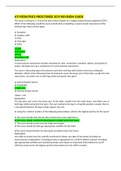Samenvatting
Corporate Entrepreneurship - summary of all lectures, tutorials and articles - by Michel Dagli
- Instelling
- Tilburg University (UVT)
Good all-in summary of: - All lectures (+ guest lectures) - All answers from the tutorials - Summary of the mandatory articles - tested among 5 people and all achieved passing grades
[Meer zien]













